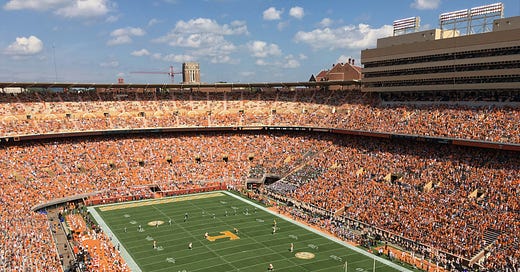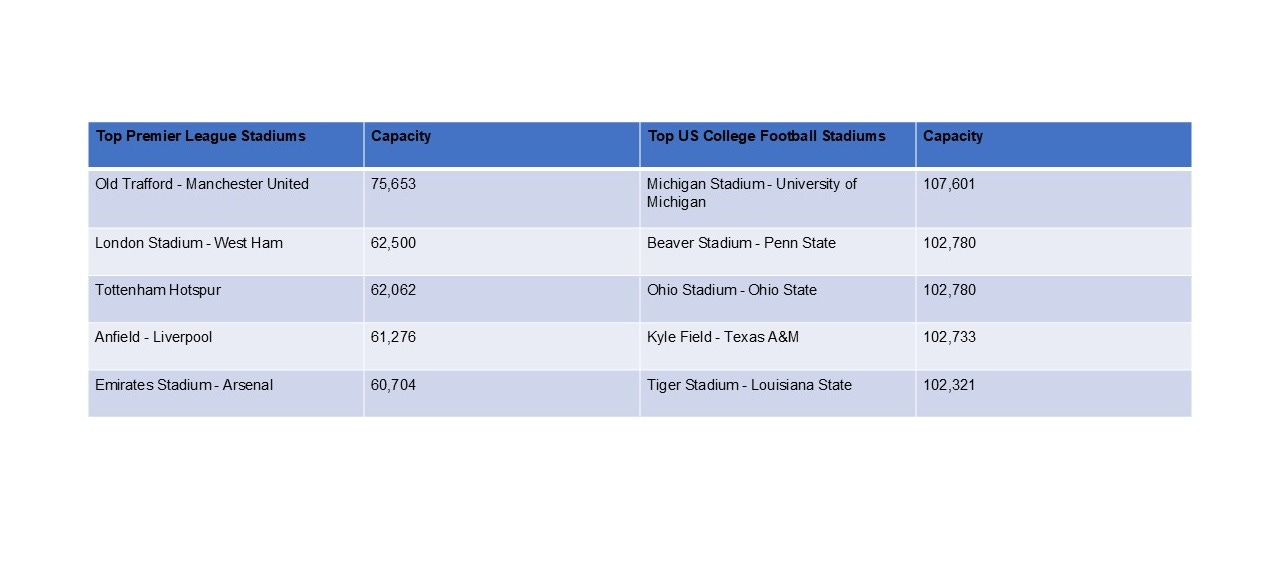Photo by Steve DiMatteo on Unsplash
With a capacity of only 101,915, Neyland Stadium in Knoxville, Tennessee isn’t even one of the top 5 biggest college football stadiums in America.
There isn’t a much more uniquely American institution than American Football. It is a sport that is really only played in North America, and while Canada has its own professional football league with rules nearly identical to its American cousin, football is indelibly ingrained in the culture of America, like it is nowhere else.
About 125 million Americans watched the Superbowl in 2024, or about ⅓ of the country. Eight of the largest ten stadiums in the world are college football stadiums and there are a number of high school football stadiums in America bigger than English Premier league stadiums.
Football is a violent game with competitors throwing each other to the ground, and crashing into each other, often with great force on each play. Continued clashing of helmets has been linked to Chronic traumatic encephalopathy (CTE), which is caused by repeated head trauma. The professional football league in America, the NFL, recently reached a $765 million dollar settlement with over 4,500 players to provide compensation and medical treatment for those suffering from CTE and other brain related injuries.
This will not stop the love of football in America. Over time maybe less mothers will let their children play the game, but there is nearly insatiable demand for the game in America. If there is football on television, it will usually beat whatever else is on offer in the ratings. Small towns in America swell to more than double their size on football Saturdays as fans come to support the home team filling stadiums that sometimes swell to over 100,000 spectators. The biggest college football stadiums are far bigger than the biggest English Premier League Stadiums. See list below.
The English Premier League plays more home games, so I’m guessing their revenue from tickets is still higher than that of college football. Premier league teams will have 19 home games for a Premier League Season, while top college programs usually have about 6 or 7 home games.
More money, more problems.
This popularity has brought with it money, and it is here where the story gets interesting. There are two extremely popular versions of football in America, college football and professional football. How these different versions of football are handling this money issue is instructive story for America. I’ll talk about college football today, and the NFL (pro football) later in the week.
Wring the neck of that golden goose.
The real product that college football is selling isn’t football. The product they are selling is community. College football has seemed to lose sight of this, and is now messing with an outrageously successful and lucrative community building sport, to chase more money.
Historically in college football teams have been in leagues organized by region, which helped to build up rivalries between teams that fueled fan interest. The Southeastern Conference included teams from the Southeast, the Atlantic Coast Conference - teams from the Atlantic Coast, the Big 10 - teams from the midwest, the Big 12 - teams from the center of America, and the Pac 10 - teams from the Pacific Coast.
I grew up a Notre Dame football fan, because my Dad went to school there and I eventually went there myself. Notre Dame is a bit unique because it doesn’t belong to a conference and has rivalries with a number of different schools, the most famous of which is with the University of Southern California, about 2,000 miles away. I grew up watching Notre Dame games on Saturdays, and even remember crying at times when Notre Dame lost.
Notre Dame last won a national championship in 1988. They will be playing for the national championship again next week. If they win, that’ll be great, but I will be watching from far away. I’ll text my friends and during the game and the next day, but that’s not the same as being there.
The product that college football sells is community. Yes, the money comes in from ticket sales, television rights and merchandise sales, but the thing that those 100,000 people are buying when they come together for a game, is the coming together for a game. There are grown men who make lots of money hosting YouTube channels detailing the in-season and off-season moves of each big program. Some of them have hundreds of thousands of subscribers. There are businesses that track high school football recruiting. College football is a mainstay on sports radio, sports television, and at the barber shop in nearly any town in America.
College football in America is an institution, a pre-game tailgate (getting to the stadium early land eating and drinking with your friends), a religion, a familiar and comforting ritual, and a way to stay in touch with friends - all rolled into one. Nothing else in America does that on the scale that college football does.
There are 858 college football teams in America. Most of these are very small and don’t involve 100,000 people getting together on a Saturday. The biggest division of college football is only about 130 teams. The average stadium for that top division (FBS) is about 50,000. If every team in America plays on a given Saturday, that is about 6.5 million people just attending the games at the top division in college football. That number doubles when you factor in people watching football on TV on any average Saturday during football season. If you add high school football, that is another 7 million people getting together as a community because of football.
That is the appeal of college football to an average American. Yes, watching the game can be exciting, but actually watching the game in the end is only a small part of the experience, and one that those that run college football seem oblivious to protect.
Follow the money.
I don’t follow college football nearly as closely as I did as a teenager, when I apparently didn’t have enough to do. Until recently, because of their run through the college football playoff, I probably couldn’t name you but a handful of the players on Notre Dame’s team. Teams can have up to 85 players on a roster. Thirty years ago, I knew nearly all of them. Now, I’ve generally moved on to other things. I like football, but I have a lot of other interests and responsibilities that take up my time, so I’ve realized that college football is nice to have, but not essential.
I check the scores every now and then, I’ll watch some highlights and if there is an especially big game I might watch, or take my children to a game at the college in the college town we live in. But I am no longer anyone who has any right to complain about the state of college football. I don’t put in very much. I am at this point a very casual fan.
But I know the history of the game, and I can see what is happening.
It was inevitable really. College football has chased the money again and again, and they are slowly but surely destroying the product they are selling (community) to enhance the product they think they are selling (big matchups on television).
History.
College football grew out of rivalries that were mostly regional, and remain so. Michigan - Ohio State, Georgia - Florida, Alabama - Auburn. For those outside the US, Auburn is in the state of Alabama. There are no professional sports in the state of Alabama, so the Iron Bowl - as the annual game is called - is the culmination of the year in sports in the state. It is always played the weekend of Thanksgiving, and if your team loses, you have to hear about it for a whole year.
I went to Notre Dame, a traditional football powerhouse, and I attended games where Notre Dame played the blue-bloods of college football such as Michigan, Penn State, Miami, Florida State, Tennessee, USC and other traditional powers. I’ve gone to my share of big games. But when my two friends offered to take me to my first Iron Bowl the year after I graduated college, I jumped at the chance. I only had one stipulation.
I made them sit on either side of me during the game. They didn’t like that, but they agreed. Bobby is an Auburn fan and David is an Alabama fan. It was a close game that Auburn ended up winning in the end. Bobby and David were miserable the whole time, because I was the only neutral fan in the whole building of 80,000 people and I gave them shit the entire game if their team played poorly. It was maybe the most fun I’ve ever had at a sporting event.
Recent Developments.
The regionality of college football has changed in recent years. Universities have seen the amounts of money they can make from increased television revenue, and they are chasing the almighty dollar. Super conferences have developed that now span the whole country and are bloated with teams. The Big 10 conference - which used to have, ten teams, now has eighteen teams and has spread across the country. Maryland will now routinely play Oregon, and Rutgers in New Jersey will play UCLA and USC from Los Angeles. How are fans supposed to travel to those games? And look beyond football. Why are we making Rutgers play UCLA in baseball, volleyball, soccer, and every other sport. The time and expense needed to transport these teams across the country just for some short-term football cash is crazy.
Traditional rivals now sometimes don’t play anymore. Washington and Washington State aren’t in the same conference anymore and don’t play. The Atlantic Coast Conference now has Stanford and Cal (in Berkeley) in their league, which are both just miles from the Pacific Ocean.
The reason for the expansion of conferences is so that marquis programs can play each other more often and drum up big television ratings. But for every Ohio State - Oregon game (two of the sport’s powerhouses), you will have many more Rutgers - UCLA, or Indiana - Washington games. Most of these games are uninteresting to the casual fan, and not that interesting to the local fan of the team, that isn’t going to fly 3,000 miles to travel to a road game, when they have been able to take a few hours car ride to their rivals stadiums for decades.
College football is making it harder, and in some cases impossible for the average local fan to participate in the community that has been build up for decades. College football is making a short-sighted and grave mistake - teaching their customers that they can do without their product. People aren’t going to travel across the country for these games in the numbers that they would travel a few hours in the past. They will then spend less time in their local football communities, and spend their time and money elsewhere. The businesses in small college towns will suffer as fans learn that they don’t need participate as much in a community that doesn’t value them as much as it used to.
Short-term television bumps for a few games a year, mean we will have less of the communities getting together to celebrate the ritual, the religion, the tradition of college football. I’m not sentimental about this. I like that ritual and that tradition, but I don’t participate in it much anymore. But it is sad to see it go.
College football in America is sacrificing the building and maintaining of community so that the rich can get richer for a little while longer before the whole system eventually collapses under its own weight. There’s a metaphor in there somewhere.





